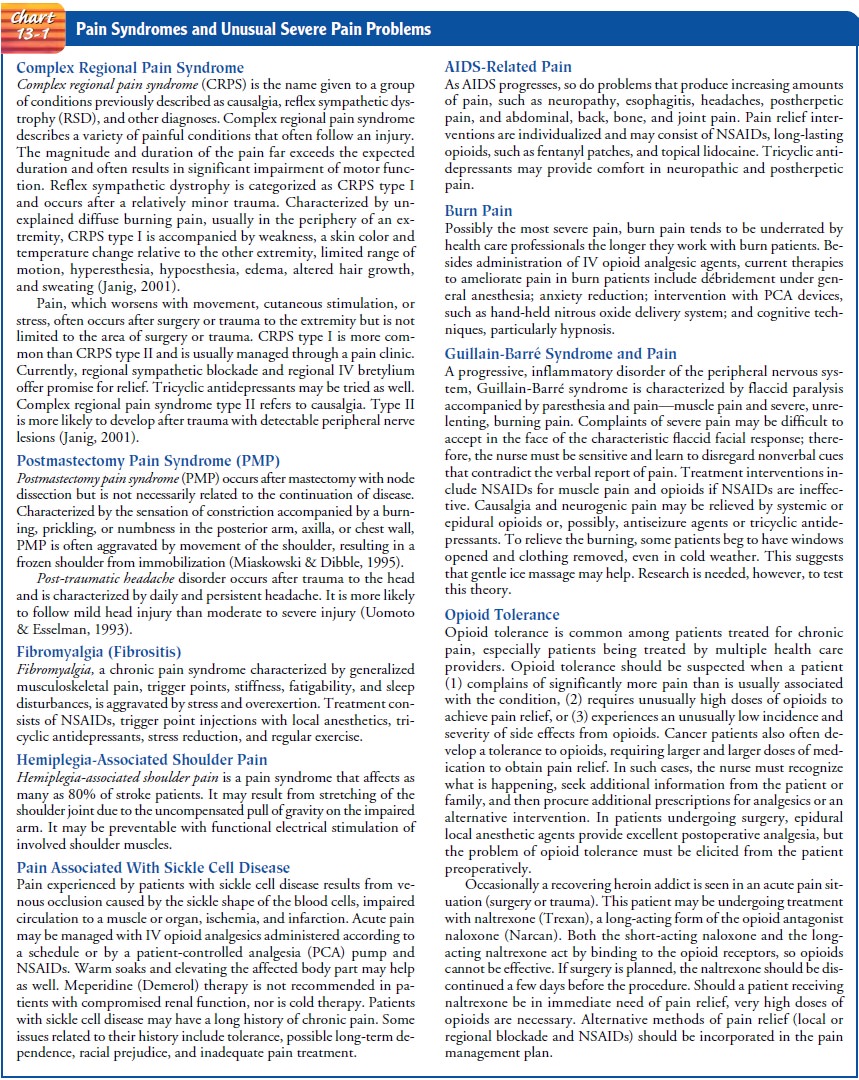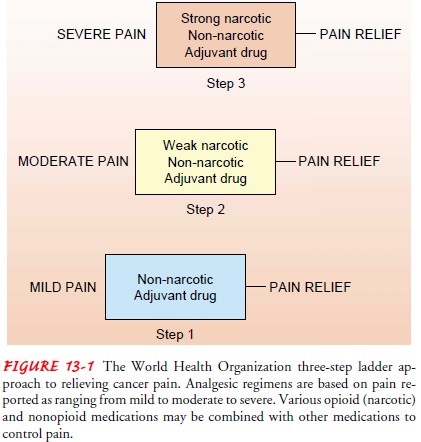Chapter: Medical Surgical Nursing: Pain Management
Types of Pain
Types of Pain
Pain is categorized according to its duration, location, and etiol-ogy.
Three basic categories of pain are generally recognized: acute pain, chronic
(nonmalignant) pain, and cancer-related pain.
ACUTE PAIN
Usually of recent onset and commonly associated with a specific injury,
acute pain indicates that damage or injury has occurred. Pain is significant in
that it draws attention to its existence and teaches the person to avoid
similar potentially painful situations. If no lasting damage occurs and no
systemic disease exists, acute pain usually decreases along with healing. For
purposes of definition, acute pain can be described as lasting from seconds to
6 months. However, the 6-month time frame has been criticized (Brookoff, 2000)
as inaccurate since many acute injuries heal within a few weeks and most heal
by 6 weeks. In a situation where healing is expected in 3 weeks and the patient
continues to suffer pain, it should be considered chronic and treated with
interventions used for chronic pain. Waiting for the full 6-month time frame in
this example could cause needless suffering.
CHRONIC (NONMALIGNANT) PAIN
Chronic pain is constant or intermittent pain that persists beyond the
expected healing time and that can seldom be attributed to a specific cause or
injury. It may have a poorly defined onset, and it is often difficult to treat
because the cause or origin may be un-clear. Although acute pain may be a
useful signal that something is wrong, chronic pain usually becomes a problem
in its own right.
Chronic pain may be
defined as pain that lasts for 6 months or longer, although 6 months is an
arbitrary period for differen-tiating between acute and chronic pain. An
episode of pain may assume the characteristics of chronic pain before 6 months
have elapsed, or some types of pain may remain primarily acute in na-ture for
longer than 6 months. Nevertheless, after 6 months, most pain experiences are
accompanied by problems related to the pain itself. Chronic pain serves no
useful purpose. If it persists, it may become the patient’s primary disorder.
The nurse may come in
contact with patients with chronic pain when they are admitted to the hospital
for treatment or when they are seen out of the hospital for home care.
Frequently the nurse is called on in community-based settings to assist
pa-tients in managing pain. For more information on common pain syndromes, see
Chart 13-1.

CANCER-RELATED PAIN
Pain associated with cancer may be acute or chronic. Pain result-ing
from cancer is so ubiquitous that after fear of dying, it is the second most
common fear of newly diagnosed cancer patients (Lema, 1997). More than half of
the 1,308 cancer patients in-cluded in a study conducted by Foley (1999)
reported being in moderate to severe pain 50% of the time. Pain in the patient
suf-fering from cancer can be directly associated with the cancer (eg, bony
infiltration with tumor cells or nerve compression), a result of cancer
treatment (eg, surgery or radiation), or not associ-ated with the cancer (eg,
trauma). Most pain associated with can-cer, however, is a direct result of
tumor involvement. An approach to cancer pain management is illustrated in
Figure 13-1. This three-step approach illustrates the types of analgesic
medications used for various levels of pain. A cancer pain algorithm developed
as a set of analgesic guiding principles appears in Figure 13-2.

PAIN CLASSIFIED BY LOCATION
The previous discussion of acute and chronic pain is an example of the
categorization of pain according to duration. Pain is some-times categorized
according to location, such as pelvic pain, headache, and chest pain. This type
of categorization is helpful in communicating and treating pain. For example,
chest pain sug-gests angina or a myocardial infarction and indicates the need
for treatment according to cardiac care standards.
PAIN CLASSIFIED BY ETIOLOGY
Categorizing pain
according to etiology is another way to think about pain and its management.
Burn pain and postherpetic neu-ralgia are examples of pain described by their
etiology. Clinicians often can predict the course of pain and plan effective
treatment using this categorization.
Related Topics